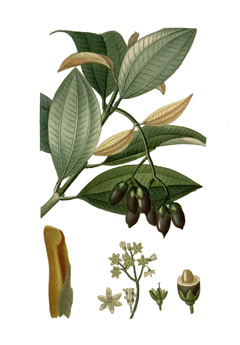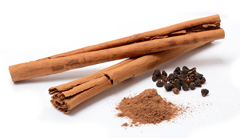 |
|
https://edibleplants.org/ |
 |
| Simon A. Eugster wikimedia.org |
Translate this page:
Summary
Cinnamomum verum or Cinnamon is a small evergreen tree native to Sri Lanka. It is usually 10 to 15 m in height and is a slow-growing plant. The leaves are ovate-oblong in shape, flowers are greenish in colour and are arranged in panicles, and the fruit is a purple drupe containing a single seed. Oil obtained from cinnamon bark is used in dental and pharmaceutical preparations. It is also used as food flavourings, alike to the stem bark and oil obtained from the leaves. Further, the bark is used to aid in digestion, relieve from headache, gastrointestinal and respiratory disorders, and as an aphrodisiac.
Physical Characteristics

 Cinnamomum zeylanicum is an evergreen Tree growing to 10 m (32ft) by 10 m (32ft) at a slow rate.
Cinnamomum zeylanicum is an evergreen Tree growing to 10 m (32ft) by 10 m (32ft) at a slow rate.
See above for USDA hardiness. It is hardy to UK zone 10 and is frost tender. The flowers are pollinated by Insects.
It is noted for attracting wildlife.
Suitable for: light (sandy), medium (loamy) and heavy (clay) soils and prefers well-drained soil. Suitable pH: mildly acid and neutral soils and can grow in very acid soils.
It can grow in semi-shade (light woodland) or no shade. It prefers moist soil.
UK Hardiness Map
US Hardiness Map
Synonyms
Cinnamomum zeylanicum Blume
Plant Habitats
Edible Uses
The stem bark is used as a flavouring[ 296 ]. A very well-known flavouring, it is used in curries and a wide range of sweet dishes. Essential oils, obtained from the leaves and the bark, are used as food flavourings in a range of foods including sauces and pickles, baked goods, confectionery and cola-type drinks[ 301 , 303 ]. The leaves are often used in cooking to impart a cinnamon flavour[ 301 ].
References More on Edible Uses
Medicinal Uses
Plants For A Future can not take any responsibility for any adverse effects from the use of plants. Always seek advice from a professional before using a plant medicinally.
Cinnamon bark oil is employed in a range of dental and pharmaceutical preparations[ 303 ]. Historically, cinnamon drops were regarded as a tonic, a sedative in childbirth, and a remedy for many common disorders. Cinnamon served as a breath sweetener in the past. In medieval times, cinnamon was distilled to produce cordials, ostensibly to aid in digestion. In the Orient, cinnamon and its near relatives are still widely used for local remedies, particularly for gastrointestinal and respiratory disorders and as an aphrodisiac. In the Philippines and the Pacific, it is taken to relieve headache. In Colombia, cinnamon sticks are chewed to speed parturition. In Ghana, bark of young shoots are used as a carminative and to treat catarrh (coryza), and the bark extract is an intestinal astringent. In Haiti, the essence is used as a poultice for rheumatism and is taken orally for spasms and for stomach and intestinal gas[ 303 ].
References More on Medicinal Uses
The Bookshop: Edible Plant Books
Our Latest books on Perennial Plants For Food Forests and Permaculture Gardens in paperback or digital formats.

Edible Tropical Plants
Food Forest Plants for Hotter Conditions: 250+ Plants For Tropical Food Forests & Permaculture Gardens.
More

Edible Temperate Plants
Plants for Your Food Forest: 500 Plants for Temperate Food Forests & Permaculture Gardens.
More

More Books
PFAF have eight books available in paperback and digital formats. Browse the shop for more information.
Shop Now
Other Uses
Other uses rating: Medium (3/5). Small shade tree, Humid shade tree, Large planter, Botanic collection, Conservatory. Other Uses: Cinnamon bark oil possesses the delicate aroma of the spice and a sweet pungent taste. Its major constituent is cinnamaldehyde but other, minor components impart the characteristic odour and flavour. It is employed mainly in the food flavouring industry but is also used in tobacco flavours and for incense. It has limited use in some perfumes[ 303 ]. Cinnamon leaf oil has a warm, spicy, but rather harsh odour, lacking the rich body of the bark oil. Its major constituent is eugenol rather than cinnamaldehyde. As a cheap fragrance, it is added to soaps and insecticides[ 303 ]. Sapwood is light brown, slightly soft; heartwood is brownish-yellow with green cast, or olive to light olive brown to blackish-brown, medium to coarse texture, satiny or silky lustre, straight and often rosy grain, spicy odour. The wood has excellent working qualities[ 303 ].
Special Uses
References More on Other Uses
Cultivation details
Cinnamon can be found at elevations up to 2,000 metres, but for commercial harvesting does best at low altitudes below 500 metres[ 303 , 418 ]. It requires a warm and wet climate with an average temperatures of about 27°c and no extremes of heat or cold[ 303 ]. Rainfall should be around 2,000 - 2,500mm, well-distributed throughout the year[ 303 ]. Although there can be months in which there is less rain, no prolonged dry season should occur and rain should be received on about 150 days per year[ 303 ]. Prefers a fertile, sandy, moisture-retentive but freely draining soil in full sun or partial shade[ 200 , 307 ]. Rocky and stony ground is unsuitable[ 303 ]. Waterlogged and marshy areas should be avoided, as they result in an undesirable, bitter product, which is much less aromatic[ 303 ]. The type of soil has a pronounced effect on bark quality[ 303 ]. Fine sandy and lateritic gravelly soils rather than rocky and stony substrates are best in Sri Lanka and India, but in the Seychelles and Madagascar more loamy soils are preferred[ 303 ]. Prefers a pH in the range 5.5 - 6.5, tolerating 5 - 7[ 418 ]. The tree usually coppices well[ 303 ]. Commercial production of cinnamon bark entails cutting the stems down low after an initial establishment period and harvesting the bushy regrowth stems at regular intervals thereafter[ 303 ]. Stems are cut during the rainy season to facilitate peeling of the bark in 2 longitudinal strips[ 303 ]. In Sri Lanka, a first harvest may be obtained after 3 - 4 years, although quality and yield improve with subsequent cuttings[ 303 ]. On plantations, cinnamon is cut every 2 years, and the flush of straight shoots generated by coppicing produces the bark that is peeled for cinnamon quills[ 303 ]. The expected yield of bark is 56 - 67 kg/ha after 3 - 4 years, subsequently increasing to 168 - 224 kg/ha[ 418 ]. About 63 kg/ha of chips and approximately 2.5 tonnes/ha of undried leaves can also be obtained[ 418 ].
References Carbon Farming Information and Carbon Sequestration Information
Temperature Converter
Type a value in the Celsius field to convert the value to Fahrenheit:
Fahrenheit:
The PFAF Bookshop
Plants For A Future have a number of books available in paperback and digital form. Book titles include Edible Plants, Edible Perennials, Edible Trees,Edible Shrubs, Woodland Gardening, and Temperate Food Forest Plants. Our new book is Food Forest Plants For Hotter Conditions (Tropical and Sub-Tropical).
Shop Now
Plant Propagation
Seed - the seed has a short viability and is best sown as soon as it is ripe[ 200 ]. Remove the fruit pulp since this can inhibit germination[ 200 ]. Germination can take 1 - 6 months at 20°c[ 164 ]. Stored seed should be sown as soon as possible in containers[ 78 ]. The seeds may be sown in nurseries or directly in the field[ 303 ]. Nursery beds should be of well-prepared rich sandy soil free from roots and stones, with an adequate supply of fresh water nearby, and be lightly shaded[ 303 ]. After about 4 months, clumps of seedlings may be transplanted into baskets and are planted out 4 or 5 months later[ 303 ]. Alternatively, the seedlings may be left in the nursery until the final transplanting, the shade having been progressively removed and the seedlings hardened[ 303 ]. Cuttings of semi-ripe side shoots, 7cm with a heel, June/July in a frame with bottom heat[ 78 ]. Division of old rootstocks[ 303 ]. The advantage of dividing old rootstocks is that the stems are ready for cutting at about 12-18 months after planting, compared with as much as 3 years for seedlings[ 303 ].
Other Names
If available other names are mentioned here
Cinnamomum verum or Cinnamon. Other Names: Ceylon cinnamon; true cinnamon. Spanish: canela; canelero. French: cannelier; cennellier de Ceylon. Portuguese: canelleira-da-India. Brazil: cinamomo. Cambodia: che'k tum phka lo‘ng. Fiji: kaloni. Germany: Ceylonzimtbaum; Kaneelbaum. India: cannalavangapattai; dalchini; karuwa; tamalapatra. Indonesia: kayu manis. Italy: albero della cannella; canella di Ceylon. Malaysia: kayu manis. Netherlands: kaneelboom. Palau: ochod ra ngebard. Papua New Guinea: skin diwai. Peninsular Malaysia: kulit manis. Philippines: cinnamon; kane-la. Samoa: tigamoni; tinamoni. Sri Lanka: kurundu. Sweden: kaneltraed.
Native Range
TROPICAL ASIA: India (Karnataka, Kerala), Sri Lanka, Myanmar (Tanintharyi)
Weed Potential
Right plant wrong place. We are currently updating this section.
Please note that a plant may be invasive in one area but may not in your area so it's worth checking.
Invasive on Indian and Pacific Ocean islands, especially the Seychelles and Samoa. Once established, it becomes the dominant tree in moist mostly lowland tropical forests [1d].
Conservation Status
IUCN Red List of Threatened Plants Status : This taxon has not yet been assessed

Growth: S = slow M = medium F = fast. Soil: L = light (sandy) M = medium H = heavy (clay). pH: A = acid N = neutral B = basic (alkaline). Shade: F = full shade S = semi-shade N = no shade. Moisture: D = dry M = Moist We = wet Wa = water.
Now available:
Food Forest Plants for Mediterranean Conditions
350+ Perennial Plants For Mediterranean and Drier Food Forests and Permaculture Gardens.
[Paperback and eBook]
This is the third in Plants For A Future's series of plant guides for food forests tailored to
specific climate zones. Following volumes on temperate and tropical ecosystems, this book focuses
on species suited to Mediterranean conditions—regions with hot, dry summers and cool, wet winters,
often facing the added challenge of climate change.
Read More
Expert comment
Author
J.Presl.
Botanical References
Links / References
For a list of references used on this page please go here
A special thanks to Ken Fern for some of the information used on this page.
Readers comment
| Add a comment |
|
If you have important information about this plant that may help other users please add a comment or link below. Only comments or links that are felt to be directly relevant to a plant will be included. If you think a comment/link or information contained on this page is inaccurate or misleading we would welcome your feedback at [email protected]. If you have questions about a plant please use the Forum on this website as we do not have the resources to answer questions ourselves.
* Please note: the comments by website users are not necessarily those held by PFAF and may give misleading or inaccurate information.
To leave a comment please Register or login here All comments need to be approved so will not appear immediately.
|
Subject : Cinnamomum zeylanicum
|
|
|
|